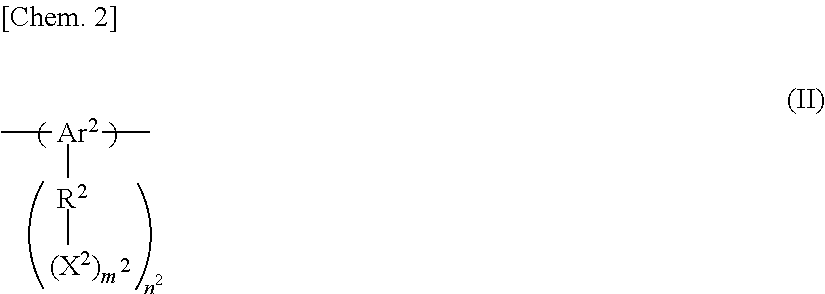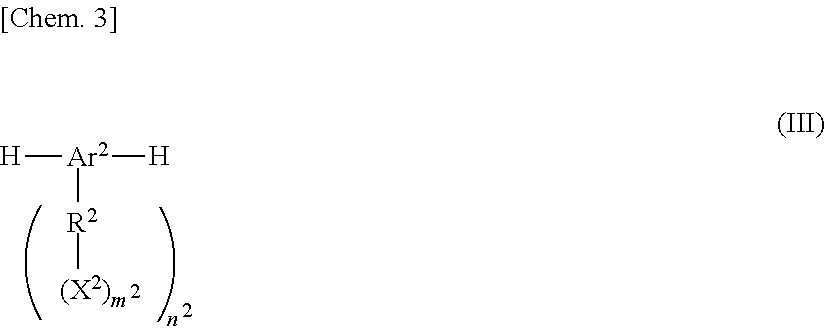Composition of silver-conjugated compound composite
- Summary
- Abstract
- Description
- Claims
- Application Information
AI Technical Summary
Benefits of technology
Problems solved by technology
Method used
Image
Examples
synthesis example 1
Synthesis of Coated Silver Particles A
[0446]A 500 mL flask was charged with 2.08 g (18.75 mmol) of polyvinylpyrrolidone (hereinafter referred to as “PVP”) (polystyrene equivalent weight average molecular weight: 55,000) and 200 mL of ethylene glycol. The resultant mixture was stirred until PVP was dissolved. Then 2.12 g (12.50 mmol) of silver nitrate was added thereto, and 50 mL of ethylene glycol was used to wash down the silver nitrate adhering to the wall surface of the flask into the flask. Then the flask was immersed in an oil bath at 165° C., and the mixture was stirred for 120 minutes, thus obtaining a dispersion liquid of silver particles.
[0447]The obtained dispersion liquid was cooled to 40° C. and then centrifuged to collect a precipitate. The collected precipitate was dried to obtain silver particles (hereinafter referred to as “coated silver particles A”).
[0448]The obtained coated silver particles A with no electrically conducting treatment were observed under an SEM to ...
synthesis example 2
Synthesis of Compound (3)
[0449]A 3,000 mL flask was charged with 52.5 g (0.16 mol) of 2,7-dibromo-9-fluorenone, 154.8 g (0.93 mol) of ethyl salicylate, and 1.4 g (0.016 mol) of mercaptoacetic acid, and the gas in the flask was replaced with nitrogen gas. Methanesulfonic acid (630 mL) was added to the mixture, and the resultant mixture was stirred at 75° C. overnight. Then the mixture was allowed to cool, added to iced water, and stirred for 1 hour. The solid generated was separated by filtration and washed with heated acetonitrile. The washed solid was dissolved in acetone, and a solid was re-crystallized from the obtained acetone solution and separated by filtration. The obtained solid (62.7 g), 86.3 g (0.27 mmol) of 2-[2-(2-methoxyethoxy)ethoxy]ethoxy p-toluene sulfonate, 62.6 g (0.45 mmol) of potassium carbonate, and 7.2 g (0.027 mol) of 1,4,7,10,13,16-hexaoxacyclooctadecane (also referred to as “18-crown-6”) were dissolved in N,N-dimethylformamide (DMF) (670 mL). The mixture was...
synthesis example 3
Synthesis of Compound (4)
[0450]The gas in a 1,000 mL flask was replaced with argon gas. Then the flask was charged with the compound (3) (15 g), bis(pinacolate)diboron (8.9 g), a [1,1′-bis(diphenylphosphino)ferrocene]dichloro palladium(II) dichloromethane complex (0.8 g), 1,1′-bis(diphenylphosphino)ferrocene (0.5 g), potassium acetate (9.4 g), and dioxane (400 mL), and these compounds were mixed and heated at 110° C. for 10 hours to reflex. The reaction solution was allowed to cool, and then filtrated. The filtrate was concentrated under reduced pressure. The reaction mixture was washed three times with methanol. Then the precipitate was dissolved in toluene. Activated carbon was added to the solution, and the solution was stirred. Then the solution was filtrated, and the filtrate was concentrated under reduced pressure, thus obtaining 11.7 g of a product. The structure of the product was determined using 1H-NMR. As a result, it was determined that the product was compound (4) repre...
PUM
| Property | Measurement | Unit |
|---|---|---|
| Percent by mass | aaaaa | aaaaa |
| Diameter | aaaaa | aaaaa |
| Band gap | aaaaa | aaaaa |
Abstract
Description
Claims
Application Information
 Login to View More
Login to View More - R&D
- Intellectual Property
- Life Sciences
- Materials
- Tech Scout
- Unparalleled Data Quality
- Higher Quality Content
- 60% Fewer Hallucinations
Browse by: Latest US Patents, China's latest patents, Technical Efficacy Thesaurus, Application Domain, Technology Topic, Popular Technical Reports.
© 2025 PatSnap. All rights reserved.Legal|Privacy policy|Modern Slavery Act Transparency Statement|Sitemap|About US| Contact US: help@patsnap.com



